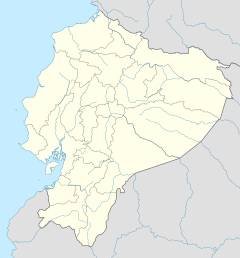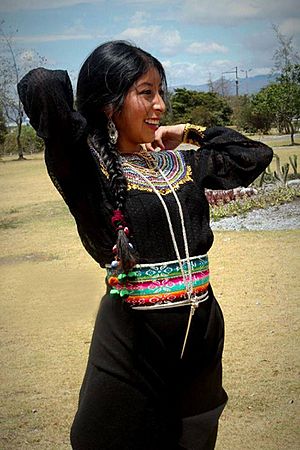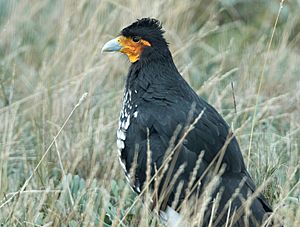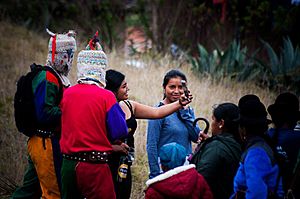Saraguro people facts for kids
Quick facts for kids
Saraguro
|
|
|---|---|
|
Town and Kichwa people
|
|
| Elevation | 2,518 m (8,261 ft) |
| Time zone | UTC- |
| Climate | Cfb |
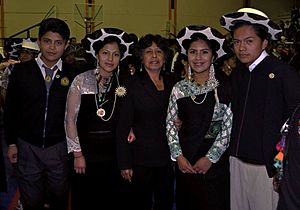 |
|
| Total population | |
|---|---|
| 30,183 (2010 census) | |
| Regions with significant populations | |
| Ecuador and some regions of the and some regions in |
|
| Languages | |
| Kichwa, Spanish | |
| Religion | |
| Andean Kichwa Cosmovision Christianity |
The Saraguro are a group of people from the Kichwa nation. Most of them live in the Saraguro Canton in the Loja Province of Ecuador. While many now speak Spanish, they also speak Runashimi or Kichwa. This is a Quechua dialect, and people are working to keep it alive. The Saraguro have also kept much of their land, traditions, and special clothing. In 2010, about 30,183 people lived in Saraguro canton. This number includes both Indigenous and non-Indigenous people.
The Saraguro people might be descendants of groups moved from far-off places during the Inca Empire. This happened in the 1400s and early 1500s.
Contents
The Saraguro Story: Where They Came From
Around the 1460s, the Inca Empire took over the Saraguro area. The people living there before the Incas might have been the Palta or the Cañari. According to old stories, the Incas moved the ancestors of today's Saraguro people from other areas. These areas might have been near Lake Titicaca or Cuzco.
The Incas had a rule called mitma. This rule meant they would move large groups of people from one part of their empire to another. This helped them mix up populations and stop people from fighting their rule. Some records say that the Saraguro ancestors were important soldiers in the Inca army. This makes sense because the Saraguro live along the Inca road, called Kapak Ñan. This road was a key link for the Incas to control their empire.
The town of Saraguro itself was likely started by the Spanish, not the Incas. However, there are many Inca ruins nearby.
The Saraguro people are proud of their Inca heritage. They celebrate it in many ways. For example, schools are named after Inca emperors. They also try to keep the Kichwa language alive. The black and white colors of their traditional clothes are very important. They represent nobility and ceremony, just as they did for the Incas. The Saraguro also connect their clothing symbols to the Curiquingue (carunculated caracara). This bird has black and white feathers and was a special bird for Inca royalty. The Curiquingue lives in the Saraguro area. Its symbols are still seen in the Kapak Raymi (Great Celebration) in Saraguro.
The Saraguro have done a better job than many other groups at keeping their land. This might be because they were not friendly to the Spanish at first. More importantly, the Spanish needed the Saraguro to run an important tambo. A tambo was like an inn or rest stop along a main travel route. The Saraguro successfully argued that they needed to keep their land to manage this tambo. They ran it until the 1940s when a new road was built.
Saraguro Clothing: What They Wear
For women:
- Anaco: This is a skirt-like garment, usually made of wool.
- Skirt: Worn under the anaco, it has pretty embroidery on the edge. This often matches the sash and shirt.
- Hat: A white woolen hat with black designs. It can be quite heavy.
- Cloth or rebozo: A black wool shawl used to keep warm. Sometimes it can be blue now.
- Earrings and tendrils: These often have crescent shapes.
- Wallka: A colorful necklace made with beads.
- Tupu: A silver jewel used to hold the shawl. It has a chain and a colored pearl. Mothers often pass the tupu down to their daughters.
- Shirt or blouse: This shirt has beautiful embroidery, now in many different designs.
- Girdle: This holds the anaco and skirt. It also stands for women's fertility and protecting the womb. Its designs should match the shirt.
For men:
- Poncho: A black wool poncho, mostly worn for special events.
- Belt: Made of leather, with gold decorations that show the man's wealth.
- Pants: Black pants that go to the knee.
- Zamarro: Made of white wool, it covers only the front part of the legs, from ankles to waist.
- Shoes: They did not wear shoes until the 1950s. Now, their shoes are black.
Saraguro Life Today
Most Saraguro people live in the Andes mountains. They live at heights between 1,800 meters (5,900 ft) and 2,800 meters (9,200 ft). For a long time, they have been farmers and raised animals. Because there isn't enough land in their home area, many have moved east. They go to the Zamora-Chinchipe Province in Ecuador. Others have moved to Europe and the United States.
Many Saraguro people today have different jobs. They are doctors, architects, engineers, musicians, and more. Some are also construction workers, artists, farmers, or business owners. They can be politicians, teachers, lawyers, cooks, or activists. Many still farm and raise animals while also having professional careers. The Saraguro have a unique identity, but they also use modern technology and are part of today's society, just like most people in Ecuador.
Fighting for Their Rights
Saraguro activists and thinkers are working hard for important causes. They are fighting for:
- Food sovereignty: This means having control over their own food supply.
- Water protection: Keeping their water clean and safe.
- Against polluting mining: Stopping mining that harms the environment.
- Indigenous resurgence: Bringing back and strengthening their Indigenous culture and ways of life.
- Indigenous Justice: Using their own traditional ways to solve problems and keep balance in the community.
- Autonomy: Having more control over their own affairs, separate from the Ecuadorian government.
Important Saraguro Leaders
Luis Macas
Luis Macas is a well-known Saraguro leader. He has special university degrees in anthropology, languages, and law. He helped start important groups like CONAIE and the Pachakutik Movement. He was also a member of Ecuador's National Congress.
Sisa Pacari Bacacela Gualan
Sisa Pacari Bacacela Gualan has worked as the Secretary for Bilingual Education in Ecuador. She has written several books, including ones about Indigenous literature and Saraguro spiritual culture.
Inti Cartuche Vacacela
Inti Cartuche Vacacela is a sociologist. He has written many articles about different cultures living together and about Ecuador being a country with many nations.
Luis Fernando Sarango Macas
Luis Fernando Sarango Macas is a lawyer and a leader in education. He belongs to the Kichwa Saraguro people. He has been a rector (like a president) of the "Amawtay Wasi" Pluriversity. This is a special school for the Indigenous Peoples of Ecuador. He also wrote a book called "The Education Paradigm of Abya Yala."
Carmen Lozano
Carmen Lozano is a Saraguro leader who has worked with many Indigenous groups. She has led peaceful marches to protect water and land from harmful resource extraction in southern Ecuador. She believes in using Indigenous justice to keep life balanced in the community. She said, “As ancestral peoples with their own autonomy, we do not accept anyone, that no government or company takes away our right to life.”
Salvador Quishpe
Salvador Quishpe Lozano is an Ecuadorian politician. He is a member of the Pachakutik party. He is currently the prefect of Zamora Chinchipe. He is known for standing up against some government policies.
Abel Sarango
Abel Sarango is the current Mayor of Saraguro canton. He is the first Indigenous person to hold this position. This is important because Saraguro has the largest Indigenous population in southern Ecuador.
Saraguro Music: A Mix of Old and New
Young Saraguro musicians are finding new ways to express themselves. They don't just stick to old traditions. They want to show that they can do many things with their lives. Many young Saraguro musicians are mixing their Saraguro Kichwa identity with modern music. They choose what parts of their traditional music to keep, make bigger, or invent new ways.
They are also finding other ways to show who they are as Indigenous people. Many young Saraguro men are fans of heavy metal music. They listen to bands from Ecuador and other countries. Some even play in local bands and organize concerts. This shows that Saraguro identity can be both traditional and modern at the same time.
Saraguro in Film
A film called Saraguro: Historia Escrita con Sangre Inka (2010) tells the story of the Saraguro people. Its title means "Saraguro: A History Written with Inka Blood." The film combines facts about people and cultures with Inca beliefs. It was made with the help of the Saraguro people themselves.
More About Saraguro
Here are some places where you can find more information about the Saraguro people and their land:
- Amawtay Wasi Pluriversity
- I.C.C.I (Scientific Institute of Indigenous Cultures)
- Saraguro.org
- Behind the scenes of the film Saraguro: Historia Escrita con Sangre Inka
See also
 In Spanish: Saraguro para niños
In Spanish: Saraguro para niños


